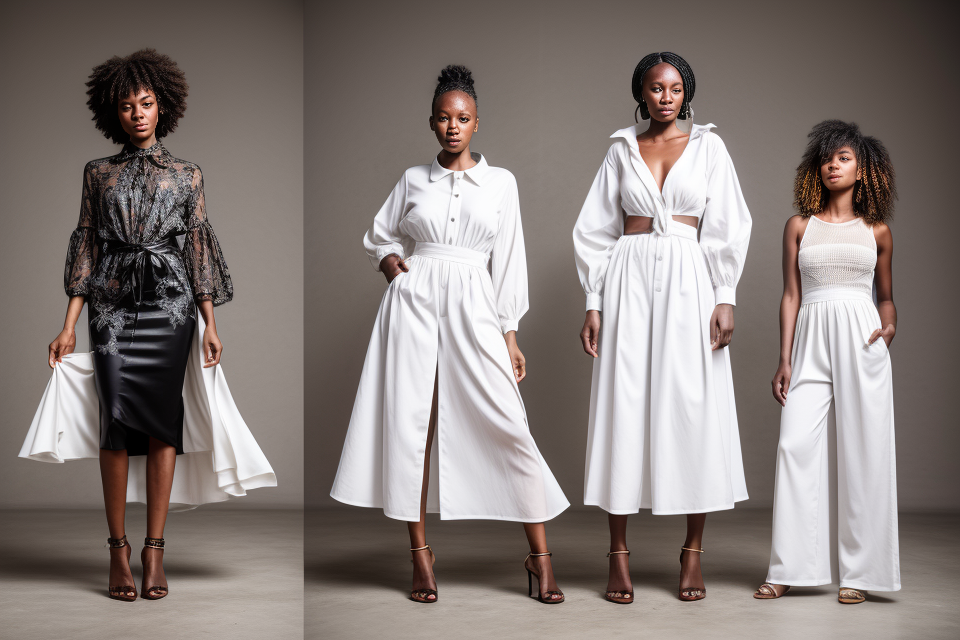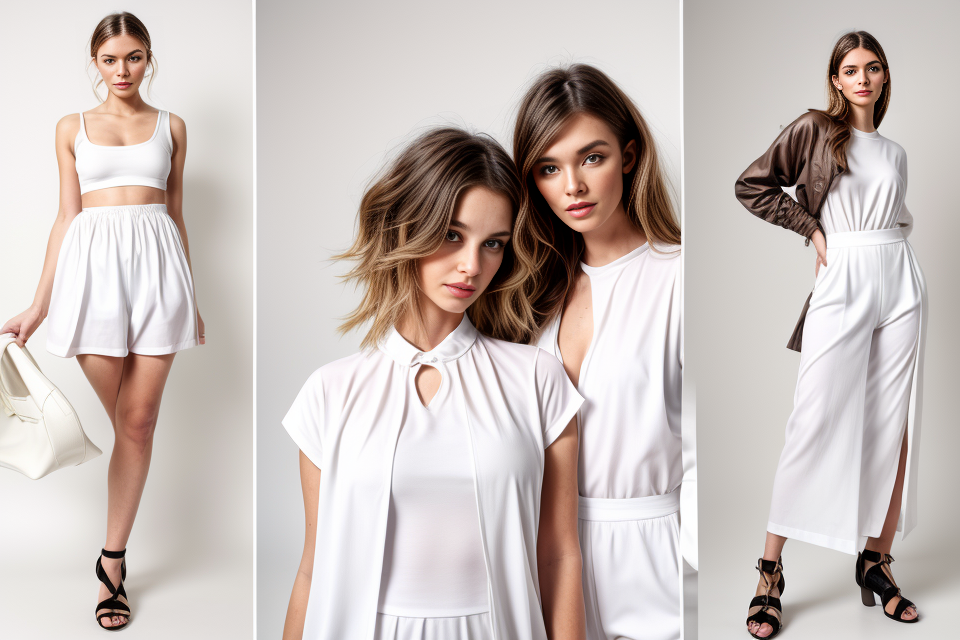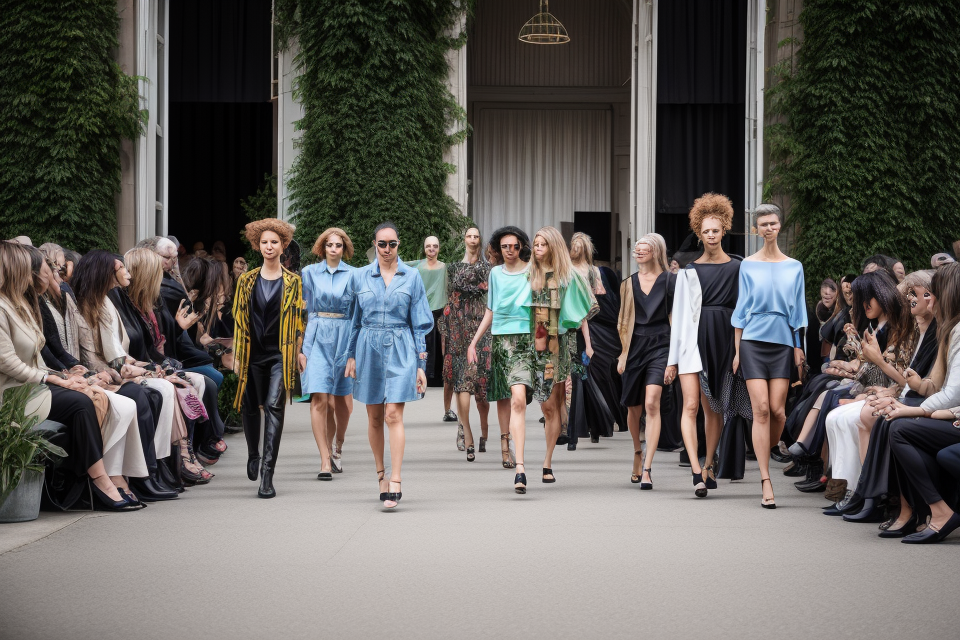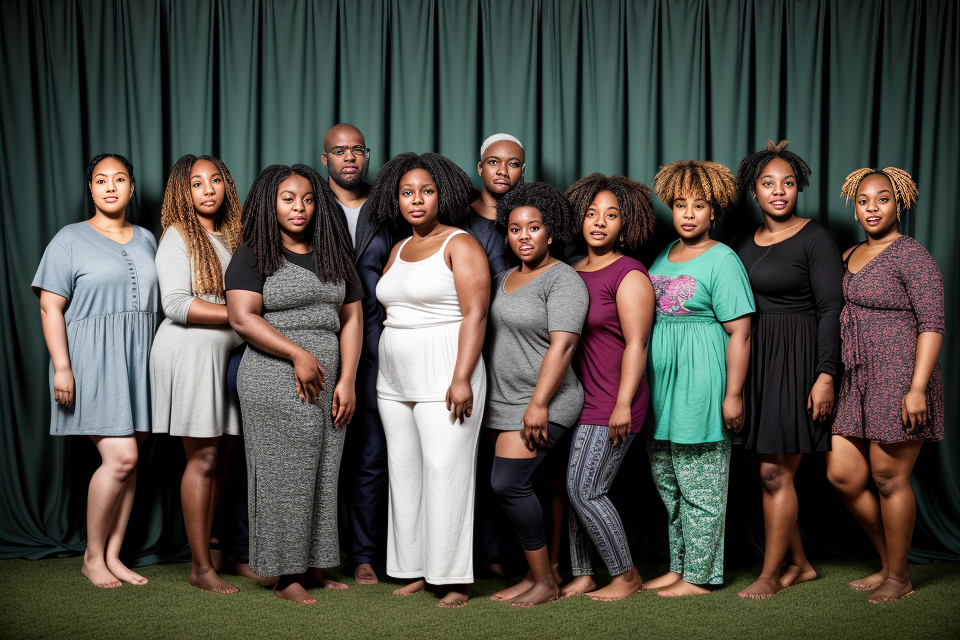Sustainable fashion is not just a trend, it’s a movement towards a better future. And for black girls, it’s a call to action to be more conscious of the clothes we wear. The 7 Rs of sustainable fashion are a guide to living a more eco-friendly lifestyle, starting with the clothes on our backs. These Rs include reducing, reusing, recycling, rotating, repairing, refinishing, and replacing. By incorporating these practices into our daily lives, we can make a positive impact on the environment and promote sustainability in the fashion industry. So let’s take action and be the change we want to see in the world.
The 7 Rs of Sustainable Fashion for Black Girls are a set of principles aimed at promoting sustainability and ethical practices in the fashion industry. These principles include Reflecting on personal style, being Resourceful, Repurposing, Renewing, Restoring, Repairing, and Reducing waste. By following these principles, black girls can make more conscious and sustainable fashion choices that are both environmentally friendly and socially responsible. This includes choosing materials that are sustainably sourced, buying second-hand or vintage clothing, and learning to repair and upcycle clothing to extend its lifespan. Additionally, supporting black-owned sustainable fashion brands and participating in clothing swaps with friends can also help promote sustainability in the fashion industry.
Understanding Sustainable Fashion
Why is sustainable fashion important?
Sustainable fashion is important for a number of reasons. One of the most pressing reasons is the environmental impact of fast fashion. Fast fashion has led to a surge in textile waste, which has a devastating impact on the environment. According to a report by the Ellen MacArthur Foundation, the fashion industry is responsible for 9% of global carbon emissions, and if the industry continues on its current path, it could use up to 30% of the world’s carbon budget by 2050. In addition to carbon emissions, fast fashion also contributes to water pollution, landfill waste, and the use of harmful chemicals.
Another reason why sustainable fashion is important is the social and economic issues in the fashion industry. The fashion industry has a long history of exploiting workers, particularly in developing countries. Workers are often paid low wages, work in poor conditions, and are exposed to harmful chemicals. In addition, the fashion industry has a history of cultural appropriation, with designs and styles being stolen from marginalized communities. Sustainable fashion seeks to address these issues by promoting ethical and fair labor practices, as well as supporting diverse and inclusive designs.
In summary, sustainable fashion is important because it addresses the environmental and social issues in the fashion industry. It promotes the use of eco-friendly materials, ethical labor practices, and diverse and inclusive designs. By embracing sustainable fashion, we can help to create a more equitable and environmentally-friendly fashion industry.
Key principles of sustainable fashion
Reduce
Reducing the consumption of new, unsustainable fashion is a key principle of sustainable fashion. This can be achieved by buying fewer, higher-quality items that are more likely to last, and by consuming more sustainable fashion brands. Additionally, consumers can reduce their environmental impact by shopping second-hand or borrowing clothing from friends or rental services.
Reuse
Reusing old clothing is another key principle of sustainable fashion. This can be done by repurposing old clothing into new items, such as turning an old t-shirt into a bag or a scarf. Additionally, consumers can donate their old clothing to charity or second-hand stores, where it can be given a new life.
Recycle
Recycling is also an important principle of sustainable fashion. This can be done by donating old clothing to textile recycling programs, or by using clothing made from recycled materials. Additionally, consumers can look for brands that use recycled materials in their products, such as recycled polyester or nylon.
Ethical and eco-friendly materials
Using ethical and eco-friendly materials is another key principle of sustainable fashion. This can include using organic cotton, bamboo, or hemp, as well as using materials that are sustainably sourced and produced. Additionally, consumers can look for brands that use recycled materials or innovative materials, such as vegan leather or piñatex, which are made from pineapple fibers.
Fair labor practices
Fair labor practices are also an important principle of sustainable fashion. This includes ensuring that workers are paid a living wage, working in safe and healthy conditions, and having the right to form labor unions. Additionally, consumers can look for brands that have been certified by organizations such as Fair Trade USA or the Global Organic Textile Standard (GOTS).
By following these key principles of sustainable fashion, consumers can make a positive impact on the environment and the lives of workers in the fashion industry.
The 7 Rs of Sustainable Fashion
1. Refuse
When it comes to sustainable fashion, the first R is to refuse. This means avoiding the purchase of new, non-essential items and not supporting brands with unethical practices. Here are some ways to put this into practice:
- Take inventory of your wardrobe and make a list of items you already have. Before making a new purchase, ask yourself if you really need it and if you already have something similar.
- Shop secondhand. Thrift stores, consignment shops, and online secondhand marketplaces are great places to find gently used items at a fraction of the cost of new clothing.
- Support sustainable and ethical brands. Look for brands that use sustainable materials, have fair labor practices, and give back to the community.
- Be mindful of fast fashion. Fast fashion is a major contributor to the fashion industry’s environmental impact and labor exploitation. Avoid brands that have a history of unethical practices.
By refusing to purchase new, non-essential items and supporting brands with unethical practices, you can make a positive impact on the environment and the people who make our clothes.
2. Reduce
When it comes to sustainable fashion, reducing is an essential part of the process. By consciously consuming less, black girls can make a significant impact on the environment. Here are some ways to reduce:
Conscious Consumption
One of the most effective ways to reduce is by being mindful of what you buy. This means purchasing fewer items and being selective about the items you do buy. By choosing quality over quantity, you can reduce waste and save money in the long run.
Buy High-Quality, Long-Lasting Items
Another way to reduce is by investing in high-quality, long-lasting items. This means spending a little more money upfront for items that will last longer and need to be replaced less frequently. Investing in timeless pieces, such as classic coats, tailored trousers, and simple dresses, can help you build a wardrobe that is both stylish and sustainable.
By reducing the amount of waste we produce, we can help protect the environment and ensure a more sustainable future for everyone.
3. Reuse
- Upcycling and repurposing old clothes
- Upcycling is the process of transforming old or discarded materials into something new and useful. In the context of fashion, upcycling involves taking old clothes and giving them a new lease of life by transforming them into something new and stylish. This not only reduces waste but also saves resources and reduces the environmental impact of fashion.
- Repurposing old clothes involves finding new ways to wear and use old clothes that may no longer be fashionable or practical. This can involve cutting clothes into new shapes, combining them with other pieces, or adding new elements such as embellishments or patches. Repurposing old clothes is a great way to give new life to clothes that may otherwise end up in landfill.
- Donating or swapping clothes with others
- Donating clothes is a great way to give new life to old clothes and help those in need. Donating clothes to charity or second-hand stores not only helps others but also reduces waste and supports sustainable fashion.
- Swapping clothes with others is a fun and sustainable way to refresh your wardrobe. This involves trading clothes with friends or participating in clothing swaps with others. Swapping clothes not only reduces waste but also encourages creativity and community building.
4. Recycle
Properly disposing of clothes through recycling programs is a crucial aspect of sustainable fashion. By recycling old clothing, we can reduce the amount of waste that ends up in landfills and help conserve natural resources.
In addition to recycling old clothing, using eco-friendly materials for clothing production is also important. These materials, such as organic cotton and recycled polyester, are sustainably sourced and produced with a lower environmental impact than traditional materials.
Furthermore, there are various ways to recycle clothes, including donating them to charity, swapping them with friends, or repurposing them into new items. This not only helps reduce waste but also encourages creativity and self-expression through fashion.
By incorporating recycling into our fashion choices, we can contribute to a more sustainable future for both the environment and future generations.
5. Rot
Extending the Life of Clothes through a Rotating Wardrobe
One of the key principles of sustainable fashion is to reduce waste and promote longevity in clothing. A simple yet effective way to achieve this is by implementing a rotating wardrobe system. This involves regularly rotating your clothes and mixing up your outfits to give the illusion of having new clothes without the need for constant purchases.
By doing this, you can avoid over-consumption of fast fashion and reduce your carbon footprint. Here are some tips on how to rotate your wardrobe:
- Store your clothes in a way that makes it easy to see everything you own. This could be by color, type of garment, or occasion.
- Plan your outfits in advance to avoid wearing the same thing multiple times without realizing.
- Mix and match different pieces to create new looks.
- Take inspiration from fashion bloggers and influencers who share their wardrobe rotation tips.
Benefits of a Rotating Wardrobe
Apart from being a sustainable practice, a rotating wardrobe also has several other benefits:
- Saves money: By making the most of what you already have, you can save money on new purchases.
- Increases creativity: Rotating your wardrobe forces you to think outside the box and come up with new outfit combinations.
- Reduces boredom: Wearing the same things over and over again can get boring. A rotating wardrobe ensures that you always have something new to wear.
- Helps declutter: By regularly rotating your wardrobe, you can identify pieces that you no longer need or want, and declutter your closet.
In conclusion, implementing a rotating wardrobe system is a simple yet effective way to practice sustainable fashion. It not only reduces waste and promotes longevity in clothing but also saves money, increases creativity, and helps declutter your closet.
6. Repair
Mending and fixing clothes instead of discarding them
In the fast-paced world we live in, it’s easy to get caught up in the latest fashion trends and want to upgrade our wardrobes constantly. However, this constant desire for new clothes can lead to a huge waste of resources and a negative impact on the environment. One way to combat this is by embracing the concept of repairing and mending our clothes instead of throwing them away.
By learning basic sewing and mending skills, we can extend the life of our clothes and keep them in good condition for longer. This not only reduces waste but also saves money as we don’t have to keep buying new clothes. In addition, repairing and mending clothes can be a creative and fulfilling activity, allowing us to personalize and update our wardrobes in a sustainable way.
Learning basic sewing and mending skills
In addition to extending the life of our clothes, learning basic sewing and mending skills can also be empowering and rewarding. It can give us a sense of accomplishment and control over our wardrobes, as well as provide a practical skill that can be used in many areas of life.
By learning how to mend and repair our clothes, we can also become more conscious of the quality of the clothes we buy and the materials they are made from. This can lead to a shift towards buying clothes made from more sustainable and durable materials, which can have a positive impact on the environment.
Overall, incorporating repair and mending into our fashion habits is a simple and effective way to practice sustainable fashion. It allows us to extend the life of our clothes, reduce waste, and become more conscious of the impact of our fashion choices on the environment.
7. Respect
Supporting black-owned sustainable fashion brands is a crucial aspect of showing respect in the fashion industry. This means actively seeking out and purchasing from these brands, rather than solely supporting mainstream brands. By doing so, consumers can help to create a more equitable fashion industry, where black designers and entrepreneurs have a greater chance of success.
In addition to supporting black-owned brands, it is also important to acknowledge and value the contributions of black fashion pioneers. These individuals have played a significant role in shaping the fashion industry, yet their contributions are often overlooked or undervalued. By recognizing and celebrating their achievements, we can help to ensure that their legacy continues to inspire future generations of black fashion leaders.
Practical Tips for Sustainable Fashion
Shopping sustainably
When it comes to shopping sustainably, there are several practical tips that black girls can follow to make a positive impact on the environment.
Researching and supporting sustainable fashion brands
One of the most important things that black girls can do is to research and support sustainable fashion brands. This means looking for brands that prioritize sustainability and ethical practices in their production processes. Some examples of sustainable fashion brands that black girls can support include Everlane, Patagonia, and Eileen Fisher.
Investing in quality, ethical, and eco-friendly clothing
Another practical tip for shopping sustainably is to invest in quality, ethical, and eco-friendly clothing. This means choosing clothing made from sustainable materials such as organic cotton, hemp, and Tencel. It also means choosing clothing that is made to last, rather than fast fashion that is designed to be disposable. By investing in quality clothing, black girls can reduce their environmental impact and save money in the long run.
Thrift shopping
Thrift shopping is another great way to shop sustainably. By shopping at thrift stores, black girls can find high-quality, gently-used clothing at a fraction of the cost of new clothing. This not only saves money but also reduces the demand for new clothing, which in turn reduces the environmental impact of the fashion industry.
Upcycling and repurposing
Upcycling and repurposing are also great ways to shop sustainably. This means taking old or unwanted clothing and transforming it into something new and unique. For example, black girls can take an old t-shirt and turn it into a stylish dress or a crop top. By upcycling and repurposing clothing, black girls can reduce their environmental impact and create a unique, one-of-a-kind piece of clothing.
By following these practical tips for shopping sustainably, black girls can make a positive impact on the environment while still staying stylish and fashionable.
Making changes in daily life
Sustainable fashion is not just about buying organic cotton or recycled materials. It also involves making changes in our daily lives to reduce waste and promote environmental consciousness. Here are some practical tips for incorporating sustainable fashion into your daily routine:
Upcycling and Repurposing Old Clothes
One of the easiest ways to practice sustainable fashion is by upcycling and repurposing old clothes. This involves taking a garment that you no longer wear or need and transforming it into something new and fashionable. For example, you can turn an old t-shirt into a crop top or a dress. This not only saves you money but also reduces the amount of waste sent to landfills.
Swapping Clothes with Friends and Family
Another way to practice sustainable fashion is by swapping clothes with friends and family. Instead of buying new clothes, you can swap your unwanted clothes with someone else’s unwanted clothes. This is a great way to refresh your wardrobe without spending any money. It also reduces the demand for fast fashion, which is a significant contributor to environmental pollution.
Participating in Clothing Swaps and Donations
Clothing swaps and donations are another way to practice sustainable fashion. Instead of throwing away clothes that are still in good condition, you can donate them to charity or participate in a clothing swap. This not only helps others but also reduces the amount of waste generated by the fashion industry. Additionally, donating clothes to charity can help you claim a tax deduction, which is a win-win situation.
In conclusion, making changes in our daily lives is an essential part of practicing sustainable fashion. By upcycling and repurposing old clothes, swapping clothes with friends and family, and participating in clothing swaps and donations, we can reduce waste and promote environmental consciousness.
Embracing personal style
Learning about personal style and fashion preferences
Embracing personal style in sustainable fashion starts with understanding one’s personal style and fashion preferences. This includes identifying what clothing styles, colors, and patterns work best for one’s body type, skin tone, and personality. By doing so, one can create a wardrobe that not only looks good but also makes them feel confident and comfortable.
Understanding the power of personal branding
Personal branding is the process of creating a unique image and identity for oneself. In the fashion industry, personal branding is essential as it helps one stand out from the crowd and establish a loyal following. By developing a strong personal brand, black girls can showcase their unique style and values, which can lead to more opportunities in the fashion industry.
Building a wardrobe that reflects personal style and values
Once one has identified their personal style and fashion preferences and created a strong personal brand, it’s time to build a wardrobe that reflects their style and values. This means investing in high-quality, sustainable clothing that aligns with their values and lifestyle. By doing so, one can create a wardrobe that is both stylish and sustainable, which can help reduce their environmental impact and promote a more sustainable fashion industry.
FAQs
1. What are the 7 Rs of sustainable fashion?
The 7 Rs of sustainable fashion are a set of principles that encourage environmentally friendly practices in the fashion industry. They are:
1. Reflect: Be aware of the environmental and social impact of your purchases.
2. Reduce: Buy fewer, higher-quality items that will last longer.
3. Reuse: Repurpose or donate old clothes instead of throwing them away.
4. Recycle: Recycle or upcycle clothing and textiles to give them new life.
5. Repair: Mend or alter clothes instead of throwing them away.
6. Research: Look for sustainable brands and materials.
7. Reward: Support brands that prioritize sustainability and ethical practices.
2. What are the 7 Rs of sustainable fashion for black girls?
The 7 Rs of sustainable fashion for black girls are similar to the general 7 Rs of sustainable fashion, but with a focus on the unique needs and challenges faced by black girls in the fashion industry. They are:
1. Reflect: Be aware of the environmental and social impact of fast fashion on black girls and communities.
2. Reduce: Buy fewer, higher-quality items that will last longer and support black-owned businesses.
3. Reuse: Repurpose or donate old clothes instead of throwing them away, and seek out vintage and second-hand clothing.
4. Recycle: Recycle or upcycle clothing and textiles to give them new life, and support brands that use recycled materials.
5. Repair: Mend or alter clothes instead of throwing them away, and learn how to sew and mend your own clothes.
6. Research: Look for sustainable brands and materials that cater to black girls’ unique styles and needs.
7. Reward: Support brands that prioritize sustainability and ethical practices, and that represent and celebrate black girls and women.
3. Why is sustainable fashion important for black girls?
Sustainable fashion is important for black girls because the fashion industry has historically excluded and exploited black communities, and continues to perpetuate harmful practices such as wasteful production and unrealistic beauty standards. By prioritizing sustainable fashion, black girls can make a positive impact on the environment and support brands that prioritize diversity, equity, and inclusion. Additionally, sustainable fashion can empower black girls to express their unique styles and identities, and to feel confident and beautiful in their own skin.
4. How can I start practicing sustainable fashion as a black girl?
Starting to practice sustainable fashion as a black girl can be as simple as making small changes in your daily routine, such as buying second-hand clothes, repairing or altering your own clothes, or researching sustainable brands. You can also get creative and upcycle old clothes, or learn how to sew and mend your own clothes. Additionally, supporting black-owned sustainable fashion brands and businesses can help to create a more inclusive and equitable fashion industry. Remember, every small action counts towards creating a more sustainable and equitable fashion industry for all.



